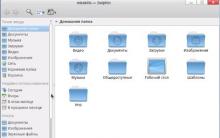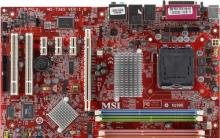The Windows operating system allows you to centrally manage fonts that can be used by all installed applications. Instead of downloading data separately to Photoshop, Microsoft Word, and some other programs, you can install a new font directly into the OS. After that, it will become available for use with any software. This article describes the process of installing new fonts in different versions of Windows: XP, 7, 8 and 10.
general information
The font determines the appearance of printed characters. The most obvious areas in which you may need such cosmetic changes are text or graphics. Writing articles, web development, creating templates for certificates or greeting cards - all this may require new custom fonts.
Connections can be divided into 2 stages: file download and installation. You can find the necessary files on specialized sites, design forums and torrent trackers. Windows supports all popular extensions: open type(OTF) true type(TTF) postscript(PFM). The installation process is the same for all types, but varies slightly in different versions of Windows.
Extract from the archive
Often, files downloaded from the Internet are packed into a special compressed folder - an archive (for example, with the extension .rar or .7z). This is done to save space on the server and reduce traffic.

To work with the contents of such objects, they must be unpacked. For this, special programs are used - archivers. If your personal computer does not have such software, you need to install it.

Download the WinRar utility from the developer's official website - http://www.win-rar.ru/download/. Be sure to choose the correct one. The program will run on any version of the OS, including the 10th.

Download the required version and install the archiver following the instructions of the Install Wizard. When the process is complete, right-click on the saved archive to bring up the settings, and select the option " Extract” (“Extract”). In the window that opens, you need to specify the folder into which you want to unpack the contents. Now you can start installation.
Windows XP
In Windows XP, there are 2 ways to install new fonts. Both are very simple - minimal computer skills are enough.
The first way is to copy the downloaded files to the desired directory manually:

You can also use the standard Windows XP tool:

Now you need to restart all active programs so that their settings are updated. After that, you can select a new font in them.
Windows 7/Vista
Compared to the XP version in Windows 7 and Vista, the developers have made the process of connecting fonts even easier:

Similar to the previous version, users can also simply copy all files to the " Windows/Fonts».
If your system drive has little space, you can place the massive "body" of the font elsewhere and connect it with a shortcut. First, this feature must be enabled in the system settings:

Now, when connecting new fonts, you can select the option " Set as shortcut».
Please note that if you delete the file or move it to another location, the font will stop working.
Windows 10 also has a similar feature, and it starts in exactly the same way.
Windows 8/10
The process of connecting fonts in Windows 8 and 10 is similar.
Firstly, users can simply move the desired files to the system directory " Fonts”, as in previous releases.

Secondly, in Windows 10 you can just open the downloaded font by double clicking on the file. In the window that opens, there will be a presentation of the appearance of the symbols, as well as the Install button. Click on it and you'll be done. As with previous versions, you will need to restart any running programs to update their settings.
Related videos
Often, after installing some applications on a computer, their Russification, updating, etc., fonts are displayed incorrectly in certain windows of these applications, as well as in the windows of the operating system itself. As a rule, this does not affect the stability of the computer, but it creates a lot of inconvenience for users, since instead of letters, hieroglyphs, squares, numbers and other characters they do not understand are displayed in windows. Often it becomes simply impossible to work on such a computer.
A significant part of users solve the problem radically - reinstall Windows or take the computer to the workshop. Although it is often possible to get out of this situation much easier. Of course, the method proposed by the author is not a panacea, but in most cases it solves the problem.
To start, Verify that the locale and language settings are correct:
(items in brackets may sometimes be missing)
- on the "Regional Options" tab: in the "Language Standards and Formats" section, specify "Russian"; in the "Location" section - your country;
If the specified settings have already been made on the computer, or after their implementation, the problems with displaying fonts have not disappeared, you need to make some changes to the system registry.
The system registry is a very important element of the operating system. That's why:
1.
In addition to the parameters listed below, do not change anything else in it if you are not sure of the correctness of your actions!
2.
Be sure to create a copy of the registry before proceeding any further! It can be used to restore the state of the system registry in case of any problems after changing it.
To create a copy of the system registry run "Registry Editor", for which we select the "Run" item in the "Start" menu. The "Running program" window will appear in the lower left corner of the screen. Enter the word regedit in it and click the "OK" button. In the "Registry Editor", in the "File" menu, select "Export". In the "Export registry file" window that opens, specify the save location, the file name of the registry copy, in the "Registry range" section (at the bottom of the window) check the "Entire registry" box, click the "Save" button.
To solve the problem with displaying fonts in Windows XP, you need to change the value of the parameters "1250" and "1252", which are located in the registry branch HKEY_LOCAL_MACHINE\SYSTEM\CurrentControlSet\Control\Nls\CodePage, from "c_1250.nls" to "c_1251.nls" and from "c_1252.nls ' to 'c_1251.nls' respectively.
How to do it:
- Run "Registry Editor").
- Sequentially opening the corresponding folders on the left side of the Registry Editor, go to the HKEY_LOCAL_MACHINE\SYSTEM\ CurrentControlSet\Control\Nls\CodePage branch. (This means that you first need to open the “HKEY_LOCAL_MACHINE” folder, open the “SYSTEM” folder in it, “CurrentControlSet” in it, etc.)
- When you get to the "CodePage" section and highlight it on the left side of the "Registry Editor", a pretty decent list of options will appear on its right side. You need to find among them the parameters "1250" and "1252". Then double-click on the first one with the left mouse button. The Edit String Parameter window opens. There, in the "Value" window, "c_1250.nls" must be changed to "c_1251.nls" and click the "OK" button (see figure). After that, similarly change the value of the parameter "1252" from "c_1252.nls" to "c_1251.nls". Click the "OK" button and restart the computer.
After rebooting, the problem with incorrect display of fonts should be gone.
Operating system fonts are the element that is always in front of our eyes, so its display should be as comfortable as possible for perception. In this article, we will figure out how to customize the font in Windows XP.
Win XP has several options for changing the size and style of characters. This can be done both for the entire interface as a whole, and for certain types of windows. In addition, desktop icon signatures, as well as fonts in some system applications, are subject to customization. Next, we will look at each option in detail.
General font size
You can change the size of labels for the entire system interface in the screen properties.

Setting the font for individual elements
On the tab "Registration" the button is located "Additionally", which provides access to the settings for the appearance of interface elements - windows, menus, icons, and so on.

You can change the font only for some positions in the drop-down list "Element". For example, let's choose "Badge"(I mean icons on the desktop).

Two more lists will appear (become active) below, containing character styles and standard sizes, as well as buttons "Fatty" And "Italics". In some cases, you can also choose a color. Changes are applied with the button OK.

Font settings in applications
Standard programs have their own settings. For example, in "Notepad" they are on the menu "Format".

Here you can select the style and size, define the style, and apply a character set from the drop-down list.

IN "Command line" you can get to the desired block of options by right-clicking on the window title and going to "Properties".

Font settings are located on the tab with the appropriate name.

Smoothing
Windows XP provides Clear Type screen font smoothing. It evens out the "ladders" on the characters, making them more rounded and softer.

Result:

As you can see, Windows XP contains a sufficient number of settings for interface fonts and applications. True, the usefulness of some functions, such as anti-aliasing, remains in question, but in general, the arsenal of tools is quite worthy.
A font in Windows is a way of displaying letters and characters. The font is usually designed in a single stylistic system.
The main characteristics of a font are saturation, contrast, width, typeface, contrast, baseline, and so on. Also associated with fonts are such concepts as size, kerning and tracking.
The combination of indicators of these characteristics creates a unique font, unlike any other.
Various fonts became available to users in the very first versions of Windows.
Fonts in Windows XP
Today we will talk about fonts in Windows XP and how to customize them.
The developers of Windows XP took care of the convenience of managing fonts for the user. There is a separate window for managing fonts - with its help you can not only view the fonts available to the user, but also add new ones and delete old ones.
Fonts in Windows XP are called as follows: open the start menu, then select the control panel. Open the fonts icon. It looks like this:
We open it, after which a list of fonts available in the system will become available to us.
The contents of the window can be displayed in different ways - in the form of a list, a table, large or small icons. In Windows XP, font similarity mode is available - when it is activated, similar ones will be displayed along with standard fonts.
Clicking the left mouse button will display the appearance of the font.
The window contains a button that displays a printed version of a particular font.
Setting up fonts involves a lot of operations.
How to install, remove and change fonts?
Removing an unnecessary font: left-click on its image, open the “file” menu on the top panel and select “delete”.
Installing a new font: open the “file” menu and click “install font”. It looks like this:

A new dialog will open in which you can select the location of the desired font.
Changing fonts goes like this.
We open the “element” list, in it we need to select the Windows component whose font we want to edit.
We have the following changes:
- font size;
- font color;
- actually, the font itself;
We make the necessary changes and save them by clicking the “OK” button.
Adjusting Font Clarity in Windows XP
The clarity of fonts in the system can be adjusted independently. We are talking about a method of smoothing screen fonts in Win XP, which is called Cleartype. This technology is provided by Microsoft itself and has been available for use for almost 15 years. Cleartype setting is also possible in Win XP.
We open through the “Start” menu “Control Panel”, then “Appearance and Personalization”. Next - find "Fonts", open the link "Cleartype text settings". A window will appear.
Item “Enable ClearType”:

mark it with a checkmark and proceed to the next setting item (click “next”).
In the next window, you will choose the screen resolution that is convenient for you.

A window will open with four text display options. We select the optimal one by clicking on it with the left mouse button. We press "next".
Cleartype mode is activated.
Font issues in Windows XP
Incorrect display of fonts does not load the operating system and does not affect the stable operation of the computer, however, it creates a lot of minor annoyances for the user. Problems with fonts occur after installing some programs, after automatic updates, etc. Many users in their hearts reinstall Win, but there are less radical ways to solve the problem. We will tell about them.
The language settings on the system must be set correctly. To do this, we make the following path: “Start”, “Control Panel”, “Date, time, language ...”. Select the “Regional Settings” tab =>>> “Language Standards…”, specify the language – “Russian”. In the "location" indicate your country.
- Tab “languages”, section “Languages and text input services”, click “details”. In the window that opens, check if the Russian keyboard matches the Russian language in the "Parameters" tab, "Installed services" section. Save by clicking "ok".
- Section "language of programs that do not support Unicode". Open the “advanced” tab, select “Russian” in it. We save the changes.
If the above settings in Win XP are enabled on the computer, then the problem can be solved through the system registry. It is done like this.
- Launch the registry editor.
- Next, expand the branch: HKEY_LOCAL_MACHINE SYSTEM CurrentControlSet Control Nls CodePage.
- The “CodePage” section contains a fairly large number of parameters. Among them, we need to find "1250" and "1252". Double-click on the first one with the left mouse button. The Edit String Parameter window should open. In “value”, change “c_1250.nls” to “c_1251.nls”. We save the result. Similarly, in “1252” we set “1251”
After the above steps, the problem with the correct display of fonts in Win XP should disappear.











Wargame: Red Dragon not starting?
Sad escobar "The face of the judicial system of Ukraine"
ROME Total War - how to unlock all factions?
How to turn off the TalkBack feature?
Overview of alternative firmware HTC Desire A8181 Bravo How to install the firmware file for HTC Desire